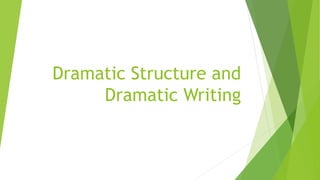
Dramatic Structure and Writing Guide
- 1. Dramatic Structure and Dramatic Writing
- 2. Dramatic Structure The structure is how the plot or story of a play is laid out, including a beginning, a middle and an end. Plays may also include subplots, which are smaller stories that allow the audience to follow the journey of different characters and events within the plot. Plays also feature an element of conflict, which does not necessarily mean a fight or argument but instead an obstacle that needs to be overcome. A typical dramatic structure is linear, with events occurring chronologically. This might include If you think of a work of literature as a building, plays, novels, and poems have a structure too. In this analogy, words are the building blocks, and the structure is what holds them together and gives the text its shape and form. Just as there are different types of structures in architecture, there are different types of structures in literature. Depending on the structure, the text is able to evoke a certain reaction in the audience or the reader.
- 3. exposition – introduces background events and characters. rising action – a series of events that create suspense in the narrative. Climax – the part of the story where the suspense reaches its highest part. falling action – the main conflict starts to resolve. resolution – the conclusion of the story where questions are answered and loose ends are tied up.
- 4. • Structures can also be non-linear, with the action of the play moving forwards and back in time. This is done through the use of flashbacks and flashforwards, to help make the play more exciting or to highlight points through contrast and juxtaposition. • Alternatively, plays may follow a cyclical structure, with the play ending at the same time as it began. This can be exciting for the audience as they try to work out how the character ended up in the position they see at the start of the play. • Traditionally, plays use acts and scenes to help define particular moments in time, and a new scene will show the audience that the action is taking place in a different location.
- 5. Genre and style The genre of a play refers to the type of story being told and is decided by the playwright. The style of a play is how the work is presented on stage. For example, a play in the tragedy genre features a serious plot with a sad ending, whereas a comedy features a light-hearted plot with a happy ending. Epic theatre, developed by Bertolt Brecht, seeks to educate the audience about political issues. It uses a range of dramatic devices to remind the audience that they are watching a play, keeping the audience intellectually and politically engaged, rather than just emotionally involved or entertained. Physical theatre, on the other hand, is a style of theatre where the storytelling or emotional content is achieved through physical movement, rather than just dialogue. Melodrama is a style that features a highly dramatic plot, an over-the-top acting style and stock characters.
- 6. Social, cultural and historical context Social – the way people lived and what they believed when the play was written and set cultural – the arts and popular interests associated with a particular time and place historical – what was happening in the world when the play was written and set •When rehearsing or studying a play, the context will inform a range of artistic decisions. For example, the historical context of a play will influence design decisions. A play that is set in the Georgian era will use costumes and set associated with that period in history.
- 7. The Way of the World, Shakespeare Theatre Company
- 8. The social context may impact character relationships and how actors use their performance skills to interpret their characters. Sometimes, directors choose to move away from a play’s original context and set it in a different period in time or a different part of the world. For example, a play may have been written hundreds of years ago but may contain themes or issues that are still prominent today, and staging the play in a different context can highlight the relevance of the play to a modern audience.
- 9. Quiz time get a ¼ sheet of paper
- 10. Matching type A. B. 1. the part of the story where the suspense reaches its highest part 2. the main conflict starts to resolve 3. the conclusion of the story where questions are answered and loose ends are tied up 4. the way people lived and what they believed when the play was written and set 5. the arts and popular interests associated with a particular time and place A. Resolution B. Social C. Cultural D. Falling action E. Climax F. Historical Direction:Read carefully the following questions before you answer, choose the answer on the column B.